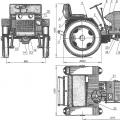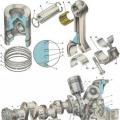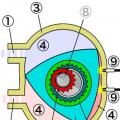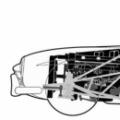Long-term safe operation of the car, reduction of fuel consumption, safety of rubber, suspensions truck largely depends on the density of the air inside the tire. See the recommended tire pressure of the truck in the table. To pump air with a compressor inside the tires, use the data in the table in the manual attached to the vehicle documents.
Importance tracking
Tire pressure monitoring is necessary, since this indicator is closely related to many parameters of the efficient and safe operation of a car, the wheels of which:
- Designed to receive torque from the engine and adhere them to the roadbed. Weak tires can cause the wheels to spin on the rim, which always has serious consequences.
- Tires are an element of transport, including freight. They absorb and soften impacts from uneven road surfaces. Lack of air while driving will cause a loss of tire elasticity and, as a result, increase the risk of rapid tread wear.
- Provide the quality of acceleration and braking of the car, excess and lack of air in the tires has a direct impact on the rate of fuel consumption.
- The stability and smoothness of traffic depends on them.
- The wheels determine the safe handling of the car, the likelihood of the car spontaneously leaving the side increases.
- Decreased tire pressure can damage the wheel casing.
The technical condition of the machine ensures a safe state of movement on the track. Any emergency condition of the car on the road can lead to serious consequences.
To avoid problems while driving on the highway, you need to maintain this criterion at the level recommended by the manufacturer.
Parameter of air density in wheels for each type road transport installed individually by the car manufacturer.
Watch the video on how to select the correct tire pressure.
The driver needs to know the condition of the tires at the moment. In cold weather, tire pressure is measured at shorter intervals than in summer.
Basic techniques
To determine the level of air pressure in the tires of a truck, dial gauges are used, in which the rule of balancing the pressure operates by the force of elastic deformation of a spring made in the form of a hollow twisted tube.
The amount of air pressure in the truck tires is of great importance, as it determines the proportionality of the load on the truck tires. The air density in the wheels of transport for the carriage of goods must be measured at least twice a week. Most reliable device For this procedure, a pressure gauge with two heads with a graduation of at least 8 bar and a scale with an interval of 0.1 bar is used.
Tire inflation pressure is an indicator that directly affects the safety of the driver and passengers. Low pressure levels can lead to delamination and tire wear. Tires with increased internal pressure, they poorly compensate for road irregularities and significantly reduce driving comfort. Trucks are very sensitive to tire pressure readings. in them the weight of the cargo is constantly changing. Accordingly, the load on the tires is different each time.
Tire pressure trucksmobile can take two main parameters:
- Maximum pressure. The maximum allowable pressure is indicated by each car manufacturer on the sidewall of the tire. It is highly discouraged to exceed this value. excessive pressure can lead to a decrease in the elasticity of the tire and its subsequent puncture.
- Recommended pressure - the tire pressure, which varies depending on the axle load and the tire size. This value is set by the manufacturer and shows the average load on a specific vehicle axle at the maximum permissible load. Recommended wheel pressure in truck can be found in a special table.
Truck tire pressure: Recommended pressure table based on axle load and tire size (front axle)
|
7,500 at 8.5 bar |
|||||||
|
6500 at 8.75 bar |
|||||||
Pressure in truck tires: table of recommended pressure according to axle load and tire size (rear axle)
|
Air pressure in bar at various axle loads |
|||||||
|
10,900 at 7.8 bar |
|||||||
|
12,000 at 8.0 bar |
|||||||
|
11,600 at 8.0 bar |
|||||||
|
13400 at 8.0 bar |
|||||||
|
12,000 at 9.0 bar |
|||||||
|
13400 at 8.0 bar |
|||||||
Pressure in truck tiresah must be checked at least four times a month. The pressure is measured on cold tires before driving. It should be borne in mind that after a trip, the pressure in truck tires can be 20-25% higher, this is due to the design features.
Buy truck tires and special tires in St. Petersburg by best prices is available in the online store "Spbkoleso".
The correct tire pressure of a truck is one of the important parameters for wheeled vehicles, as it affects many characteristics. In this article, we will figure out what the correct pressure should be in the tires of a truck. Basically, the following depends on the pressure:
- ride comfort in a car, which is important for long trips;
- optimum mileage and fuel consumption;
- transfer of forces during acceleration of the car.
In addition to the factors described above, incorrect pressure is one of the causes of emergency situations on the road. When the permissible norm is lowered, the car frame strongly compresses, which results in unfavorable factors:
- significant reduction in tire life due to uneven wear;
- overheating of a truck tire;
- rolling resistance increases significantly.
ATTENTION! Found a completely simple way to reduce fuel consumption! Don't believe me? An auto mechanic with 15 years of experience also did not believe until he tried it. And now he saves 35,000 rubles a year on gasoline!
 These are just a few of negative consequences incorrect tire pressure cargo type... For example, lowering the rate by only 30% leads to a significant increase in fuel consumption, equal to one tenth of standard waste. In addition, to the negative factors is added the doubled tire wear. Braking distances also get 15% longer.
These are just a few of negative consequences incorrect tire pressure cargo type... For example, lowering the rate by only 30% leads to a significant increase in fuel consumption, equal to one tenth of standard waste. In addition, to the negative factors is added the doubled tire wear. Braking distances also get 15% longer.
Exceeding standards, as well as underestimating them, also leads to negative results.
The main problem that truck owners face when driving with inflated tires is their uneven wear and, as a result, significantly increased wear.
Reduced tire life increases vehicle maintenance costs and can lead to accidents. Correctly inflated tires avoid all of the above problems, as well as optimize fuel consumption and halve the cost of changing tires.
Selection of pressure in truck tires
 Finding the correct pressure for truck tires is quite simple, since almost every car manufacturer indicates the nominal values \u200b\u200bin the instruction manual for wheeled vehicles. Usually, two numbers are indicated, which indicate the level of inflation of the wheels.
Finding the correct pressure for truck tires is quite simple, since almost every car manufacturer indicates the nominal values \u200b\u200bin the instruction manual for wheeled vehicles. Usually, two numbers are indicated, which indicate the level of inflation of the wheels.
One of them is for a car without luggage, the second is for a loaded truck. If only one value is written, then it is intended for an empty car, and with heavy wheel loads, you need to inflate the tires by 0.3-0.5 atmospheres. This rule is also true for long trips in an unloaded vehicle.
Such changes in the inflation of car tires are necessary due to the fact that the ideal operating conditions for a truck are proportional to the load on the wheel and the pressure inside it.
To maximize your safety while driving, you need to check the amount of atmospheres in the tires at least 2 times a week. The check is carried out before the car starts to be actively used, since when driving, the tire pressure changes due to heating and can be higher than with cold tires.
Correct Truck Tire Pressure
There is a concept of "correct pressure" for wheeled vehicles of a cargo type. It can be divided into 3 main types.
If not for the pneumatic tire, the car would hardly have achieved the popularity it has now. And if you look at it, the tire is just a tank filled with air, which needs to withstand a certain load for a certain time. The truck tire works in a very difficult conditions, therefore, it is to her that more claims are made than to the passenger one.
The most important performance parameter
The most important parameter in tire operation is the ratio between applied load and chamber pressure. It is quite simple to check it, but this is the main problem during operation. It is not checked as often as necessary and does not meet the rating for certain tires and operating conditions.

The pressure in the tires of the truck, the table of which is presented in several versions (for single, front wheels, for coupled, rear wheels and for semi-trailer and trailer wheels) is the factor that forms the contact patch between the tire and the surface. By observing the correspondence of load and pressure, it is possible to ensure maximum long term tire service, improve road safety and affect fuel consumption.

Tire pressure and economy
In the dry language of numbers, compliance with the optimal proportion of pressure and load is expressed as follows:

The lower the pressure in the tire, the more the carcass, the cord is compressed. And depending on the material, fatigue and full wear can occur even before the tread reaches its end of life. Here is a memo issued for drivers in the early 50s:

Correct tire pressure

Therefore, the pressure must be correct, but one parameter is most often indicated on the tire and in the tables, although there are at least three of them:

The maximum pressure is usually indicated on the sidewall of the tire in accordance with the standards of the country in which the tire was produced. In no case should this limit be exceeded, otherwise the tire may simply collapse on the go. Optimal pressure means the ideal proportion of load and pressure in the wheel, but it is almost impossible to reach its value. On each of the trips, the truck is loaded differently; it is not possible to control the parameters on the go on every vehicle.

The vehicle passport offers its own version of the pressure in the wheels and it fully corresponds to the axle load, not in general, but for a specific truck. Deviation from this parameter greatly affects the final mileage of the tire, which ultimately affects the profitability of the operation of the equipment.
Why is wrong pressure dangerous?
Now it is worth dotting the high and low pressure, how they are dangerous and when you can violate the permissible values \u200b\u200bgiven in the tables. High pressure in truck tires may result in:

Low blood pressure can also provide some unpleasant surprises:

However, in some cases, a short-term decrease in pressure can help to overcome the viscous complex road surface: soils, sand, soft soil, provided that the axle load is not more than two tons. In this case, a short-term decrease in tire pressure by 12-15% is allowed.
Tire temperature and pressure

When inflating truck tires, one cannot ignore climatic conditions and just the season. It should be noted that when the temperature rises to 20 degrees, the pressure in the wheels will increase by 0.7 bar. In winter, when the air temperature drops to the same, but negative value, the pressure in the wheels will drop by 0.6-0.8 bar. In the event that the car is loaded, these figures will differ even more from the nominal values.

Therefore, the tire pressure must be monitored and controlled as often as possible. Then the operating costs of the truck will be significantly reduced and the safety and resource will increase. Good luck to all roads and light cargo!
A truck is a source of income, so to speak, a breadwinner. But if tire pressure is not kept within acceptable limits, it can become a source of losses. A negligent attitude towards this operational parameter threatens not only an accident. This includes fuel consumption, repair costs, and the purchase of new skates.
Why is it important to monitor blood pressure?
Incorrect tire pressure is the cause of the following consequences of vehicle operation:
- Reduced tire life.
- Fuel consumption increases.
- Undercarriage parts wear out.
- The risk of becoming a participant in an accident increases.
- The load on all components (frame, body, cab, engine, etc.) increases.
It is the responsibility of the driver to maintain the pressure in the tires of the truck, and the control of performance is the responsibility of the mechanic, expert, business owner.

Where to find out how much pressure should be?
The standard pressure indicators are indicated in the table contained in the technical documentation for the machine. But if the care and operation manual is lost or become unusable, you can peep the information in the table on a metal plate attached to the cab body in the doorway, like a Gazelle. But even then it is necessary to take into account a number of factors affecting the degree of tire inflation.
What pressure should a cargo Gazelle have?
For most modifications of cargo Gazelles, the manual says that the tire pressure must be maintained at 2.9 atmospheres. However, the manufacturer does not take into account that this parameter may differ depending on operational features:
- In what mode the truck is most often used (loaded or empty).
- Tire model. Each manufacturer specifies the maximum allowable tire pressure, ensuring that it does not explode while the truck is moving.
All drivers have their own calculation system. Most of them, moving most often empty or half empty, pump 2.9 atm., As required by the manufacturer. The pressure in the tires of the cargo Gazelle, which is constantly operated at full load, is raised to 3.5-4.0 atm. Such a system is suitable not only for the Gazelle, but also for the tires of other trucks.

Why is the pressure in the tires of trucks overstated?
Professional car drivers aim to keep the car in good order. In order for the roll to be easier, and the wear of the rubber is less, they overestimate the pressure, making it 0.5 atm. higher than official truck tire pressures. At the same time, driving becomes less comfortable, vibration and shaking are felt more strongly, especially when the car is driving empty.
Air density control system in slopes of a truck
There are permissible deviations in gauge readings associated with the following factors:
- Decrease in air compression ratio over time. Deviations of 0.3-0.4 atm. from the data in the table is considered normal if the last measurement was made a month ago.
- If the control is carried out immediately after the end of the trip, the pressure gauge reading will be 20% higher than the standard value.
Experienced drivers say: Not only the manometers are lying, but also the sensors provided by the car manufacturer. While driving, the rubber heats up, and the air inside the cylinder also. As a result, the sensor indicates that the wheel is over-pumped. But as soon as the car stops, the sensor will show normal data, as soon as the temperature returns to normal.
Wheel pumping control should be done once every two weeks, at least. Otherwise, you can miss the moment. The tire will start to wear out quickly, the car will be less controlled, and fuel consumption will increase.

Dependence of pressure and radius
Summary tables of permissible pressure gauge readings include a list of tires of various profiles. The pressure also varies. So, if we compare the radius of 17.5 and, say, 22.5, then in the latter case the pressure will be higher. Moreover, the difference will be very significant. For a radius of 17.5, the recommended values \u200b\u200bare:
- before - up to 5.4 atm.;
- back - up to 6.0.
If the tire is 22.5, then it will be 5.0 / 6.0 atm. respectively. But these figures correspond to the full load of the machine.
Visual signs of mismatch
During the operation of the car, the rubber should wear out evenly. One-sided wear has nothing to do with it, most likely this is evidence of an incorrectly set camber-convergence. But if the tire has wear in the center of the tread, then you are driving on inflated wheels.

Reverse situation with insufficient pumping. In this case, the wear is visible from both sides of the center, and is the same. In any case, it makes sense to think, rectify the situation and watch how the tread wears off. Indirect symptoms are increased consumption fuel, the severity of the stroke, shaking, vibration. To always be able to control the situation, you need to carry a pressure gauge (mechanical or electronic) with you.




